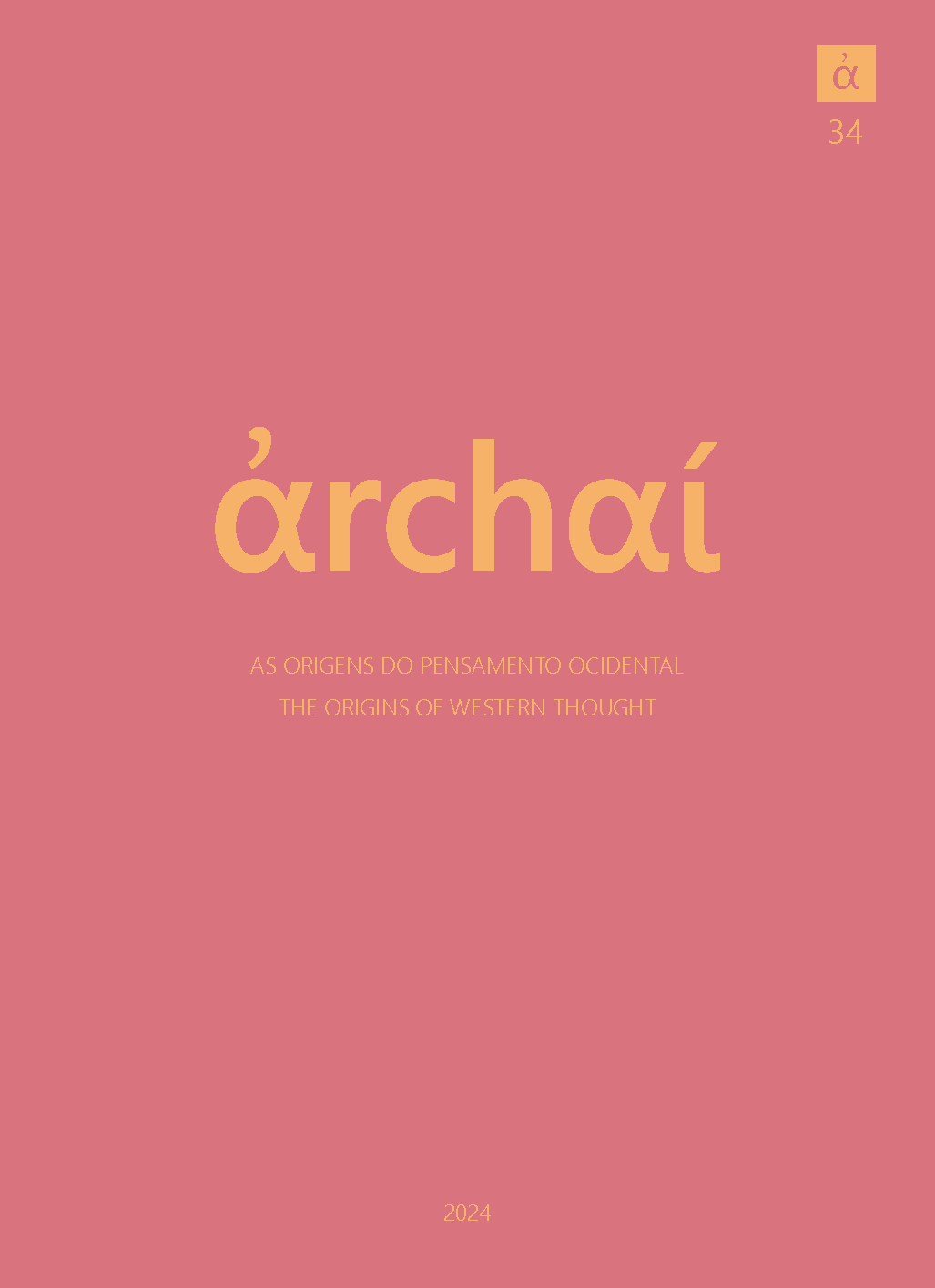How to Name Invisible Principles? The Challenge of Naming What the Eyes Cannot See
DOI:
https://doi.org/10.14195/1984-249X_34_11Palavras-chave:
Democritus, indivisible, names, presocratics, languageResumo
What were the guidelines that the ancient atomists followed when coining new terms to name their principles? To what extent the difficulty of apprehension and understanding of the nature of their principles would justify the use of more than one term for naming the same thing? Some modern scholars tend to reduce the “indivisible” to a mere formal principle, while other scholars insist in considering the “indivisible” as a material principle. Can anyone find in the ancient texts sufficient elements to evaluate these claims without losing sight of the particular horizon of inquiry and conceptual universe of Presocratic philosophy? I intend to map the problem of the names assigned to the principles in the atomists’ thought in order to formulate a few hypotheses concerning some issues that seem to underlie the transmission and the reception of their thought in antiquity.
Referências
ARISTOTELIS (1957). Metapphysica Recognivit brevique adnotatione critica instruxit. W. Jaeger. Oxford: Oxford University Press.
BERNABÉ, A. (2013). El vocabulário filosofico griego: nacimiento de una terminologia. In: Los filósofos presocraticos. Literatura, lengua y vision del mondo Campillo Nevado: Evohé.
DIELS, H.; KRANZ, W. (1998). Die Fragmente der Vorsokratiker Griechisch und Deutsch 3 v. Zurique: Weidmann.
FERRARI, G. A. (1980). La scrittura fine della realtà. Siculorum Gymnasium, v. 33, p. 75-89.
GEMELLI MARCIANO, M. L. (2007). Democrito e l’Accademia. Studi sulla trasmissione dell’atomismo antico da Aristotele a Simplicio Berlim/New York: Walter de Gruyter. (Col. “Studia Praesocratica").
GRAHAM, D. W. (ed. and trans.). (2010). The Texts of Early Greek Philosophy. The Complete Fragments and Selected Testimonies of the Major Presocratics 2 v. New York: Cambridge University Press.
HUFFMAN, C. (2019). Pythagoreanism. In: ZALTA, E. N. (ed.). The Stanford Encyclopedia of Philosophy (Fall, 2019 Edition). Available at: Available at: https://plato.stanford.edu/archives/fall2019/entries/pythagoreanism/. Accessed on: Nov. 25, 2022.
» https://plato.stanford.edu/archives/fall2019/entries/pythagoreanism/
LURIA, S. (ed.). (2007). Democrito. Raccolta dei frammenti. Interpretazione e commentario di Salomo Luria Introduzione di Giovanni Reale Testi greci e latini a fronte. Versione russa in appendice. Milão: Bompiani. (Col. “Il Pensiero Occidentale”).
MOREL, P.-M. (1998). Démocrite. Connaissance et apories. Revue Philosophique de la France et de l’Etranger, v. 2, p. 145-163.
MOREL, P.-M.; VERDE, F. (2013). Le Contre Colotès de Plutarque et son prologue. Aitia, online, (#3, 2013; uploaded Nov. 25, 2013). Available at: Available at: http://journals.openedition.org/aitia/602 Accessed on: Dec. 27, 2022.
» http://journals.openedition.org/aitia/602
MORICI, I. M. (2006). Considerações acerca do caráter convencional da linguagem em Demócrito. Scripta Clássica on-line Literatura, Filosofia e História na Antigüidade, n. 2. Available at: Available at: https://www.scriptaclassicaonlinebr.gr.eu.org/igor.pdf Accessed on: Nov. 30, 2022.
» https://www.scriptaclassicaonlinebr.gr.eu.org/igor.pdf
PEIXOTO, M. C. D. (2012). Heráclito e Parmênides: a experiência dos sentidos entre o visível e o invisível. In: PEIXOTO, M. C. D.; MARQUES, M. P.; PUENTE, F. R. O Visível e o Inteligível: Estudos Sobre a Percepção e o Pensamento na Filosofia Grega Antiga Belo Horizonte: Editora da UFMG.
PEIXOTO, M. C. D. (2010). Rhusmos e movimento dos átomos na física de Demócrito. Kriterion, v. 122, p. 413-428.
TAYLOR, C. C. W. (1999). The Atomists: Leucippus and Democritus. Fragments A text and translation with a commentary by C. C. W. Taylor. Toronto/Buffalo/London: University of Toronto Press.
Downloads
Publicado
Edição
Seção
Licença
Copyright (c) 2024 Miriam Campolina Diniz Peixoto

Este trabalho está licenciado sob uma licença Creative Commons Attribution 4.0 International License.
Dado o acesso público desta revista, os textos são de uso gratuito, com obrigatoriedade de reconhecimento da autoria original e da publicação inicial nesta revista. O conteúdo das publicações é de total e exclusiva responsabilidade dos autores.
1. Os autores autorizam a publicação do artigo na revista.
2. Os autores garantem que a contribuição é original, responsabilizando-se inteiramente por seu conteúdo em caso de eventual impugnação por parte de terceiros.
3. Os autores garantem que a contribuição que não está em processo de avaliação em outras revistas.
4. Os autores mantêm os direitos autorais e concedem à revista o direito de primeira publicação, sendo o trabalho licenciado sob a Creative Commons Attribution License-BY.
5. Os autores têm permissão e são estimulados a publicar e distribuir seu trabalho on-line após a publicação na revista.
6. Os autores dos trabalhos aprovados autorizam a revista a, após a publicação, ceder seu conteúdo para reprodução em indexadores de conteúdo, bibliotecas virtuais e similares.
7. É reservado aos editores o direito de proceder ajustes textuais e de adequação do artigo às normas da publicação.



